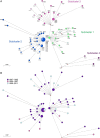Tracking a tuberculosis outbreak over 21 years: strain-specific single-nucleotide polymorphism typing combined with targeted whole-genome sequencing
- PMID: 25362193
- PMCID: PMC4447836
- DOI: 10.1093/infdis/jiu601
Tracking a tuberculosis outbreak over 21 years: strain-specific single-nucleotide polymorphism typing combined with targeted whole-genome sequencing
Abstract
Background: Whole-genome sequencing (WGS) is increasingly used in molecular-epidemiological investigations of bacterial pathogens, despite cost- and time-intensive analyses. We combined strain-specific single-nucleotide polymorphism (SNP) typing and targeted WGS to investigate a tuberculosis cluster spanning 21 years in Bern, Switzerland.
Methods: On the basis of genome sequences of 3 historical outbreak Mycobacterium tuberculosis isolates, we developed a strain-specific SNP-typing assay to identify further cases. We screened 1642 patient isolates and performed WGS on all identified cluster isolates. We extracted SNPs to construct genomic networks. Clinical and social data were retrospectively collected.
Results: We identified 68 patients associated with the outbreak strain. Most received a tuberculosis diagnosis in 1991-1995, but cases were observed until 2011. Two thirds were homeless and/or substance abusers. Targeted WGS revealed 133 variable SNP positions among outbreak isolates. Genomic network analyses suggested a single origin of the outbreak, with subsequent division into 3 subclusters. Isolates from patients with confirmed epidemiological links differed by 0-11 SNPs.
Conclusions: Strain-specific SNP genotyping allowed rapid and inexpensive identification of M. tuberculosis outbreak isolates in a population-based strain collection. Subsequent targeted WGS provided detailed insights into transmission dynamics. This combined approach could be applied to track bacterial pathogens in real time and at high resolution.
Keywords: genomic epidemiology; outbreak; screening; tuberculosis; whole genome sequencing.
© The Author 2014. Published by Oxford University Press on behalf of the Infectious Diseases Society of America. All rights reserved. For Permissions, please e-mail: journals.permissions@oup.com.
Figures






References
-
- Cook VJ, Shah L, Gardy J, Bourgeois A-C. Recommendations on modern contact investigation methods for enhancing tuberculosis control. Int J Tuberc Lung Dis 2012; 16:297–305. - PubMed
-
- McElroy PD, Rothenberg RB, Varghese R, et al. A network-informed approach to investigating a tuberculosis outbreak: implications for enhancing contact investigations. Int J Tuberc Lung Dis 2003; 7:S486–93. - PubMed
-
- Cook VJ, Sun SJ, Tapia J, et al. Transmission network analysis in tuberculosis contact investigations. J Infect Dis 2007; 196:1517–27. - PubMed
-
- Anderson LF, Tamne S, Brown T, et al. Transmission of multidrug-resistant tuberculosis in the UK: a cross-sectional molecular and epidemiological study of clustering and contact tracing. Lancet Infect Dis 2014; 14:406–15. - PubMed
Publication types
MeSH terms
Substances
Grants and funding
LinkOut - more resources
Full Text Sources
Other Literature Sources
Medical

